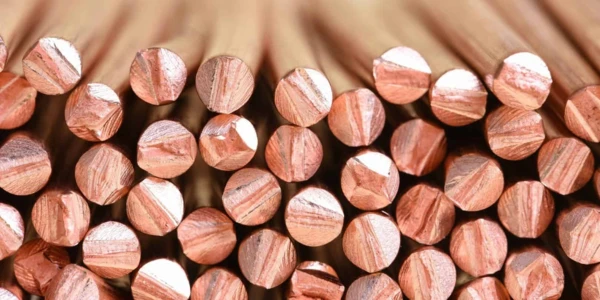
21.08.2023 by Aileen Sammler, Dr. Dmitry Sergeev
Metallic Trend: About the Thermophysical Properties of Copper and its Alloys
Copper features exceptional electrical and Thermal ConductivityThermal conductivity (λ with the unit W/(m•K)) describes the transport of energy – in the form of heat – through a body of mass as the result of a temperature gradient (see fig. 1). According to the second law of thermodynamics, heat always flows in the direction of the lower temperature.thermal conductivity, ranking just behind silver as one of the best conductors. Studies illustrate a massive increase in copper and copper alloy sourcing, which includes materials like bronze, brass, and other alloys. They are mainly used in aerospace, machinery manufacturing and in industrial component markets.
The Rising Need for Copper
Copper features exceptional electrical and Thermal ConductivityThermal conductivity (λ with the unit W/(m•K)) describes the transport of energy – in the form of heat – through a body of mass as the result of a temperature gradient (see fig. 1). According to the second law of thermodynamics, heat always flows in the direction of the lower temperature.thermal conductivity, ranking just behind silver as one of the best conductors. A lately published report by S&P Global predicts that until 2035, the worldwide requirement for copper might witness a surge, potentially doubling from its current state, from 25 to 50 million metric tons. Further studies also illustrate a massive increase in copper alloy sourcing, which includes materials like bronze, brass, and other alloys. They are mainly used in aerospace, machinery manufacturing and in industrial component markets.
Nowadays, copper is also pivotal for contemporary innovations such as electric machinery, sustainable energy infrastructure, electronic gadgets, and advanced cooling and heat transfer systems. Furthermore, copper finds use in modern conveniences, including automation, robotics, computational power, and fast energy transmission.

Factors Amplifying Copper Consumption
- Electrical Infrastructure: Copper´s Electrical Conductivity (SBA)Electrical conductivity is a physical property indicating a material's ability to allow the transport of an electric charge.electrical conductivity and durability has established it as a preferred material for both households and industrial electrical systems.
- Renewable Energy: The transition to renewable energy sources involves an increase in the use of copper, as solar and wind energy systems require significantly more copper than traditional fossil-fueled systems.
- Electric Cars and Trucks: Growing accessibility and enhanced battery technologies have already bolstered sales of electric vehicles. As each electric car and truck utilizes significantly more copper than conventional combustion engines, the surge in electric vehicle production suggests an increase in copper demand.
- Medical Care: Copper is extensively used in medical technology not only for its high Electrical Conductivity (SBA)Electrical conductivity is a physical property indicating a material's ability to allow the transport of an electric charge.electrical conductivity, which is very important for different medical devices, but also for its natural antibacterial properties.
Thermophysical Properties of Copper and its Alloys
The thermophysical properties of copper and its alloys contribute to their widespread use in various industries, including electronics, electrical engineering, aerospace, automotive, and heat transfer applications. The properties are also crucial in engineering design and material selection to ensure optimal performance in specific applications.
Although the main properties of pure copper are already known, there is still a great need for further experimental determination of the mechanical, thermodynamic and thermophysical properties of its alloys and intermediate compounds, as well as copper occurring in special forms such as thin films or with different grain sizes. (Figure 1)

Discover how NETZSCH Analyzing & Testing can assist in determining the properties of copper containing alloys!
For example, Laser Flash Analysis (LFA) provides fast and accurate measurements of the Thermal ConductivityThermal conductivity (λ with the unit W/(m•K)) describes the transport of energy – in the form of heat – through a body of mass as the result of a temperature gradient (see fig. 1). According to the second law of thermodynamics, heat always flows in the direction of the lower temperature.thermal conductivity of copper and its alloys over a wide temperature range. LFA can also be applied to thin films and small samples, beneficial in modern technology applications where copper appears in such forms. Here, the use of PicoTR/NanoTR Time Domain Reflectance Technology for particularly thin films is also possible.